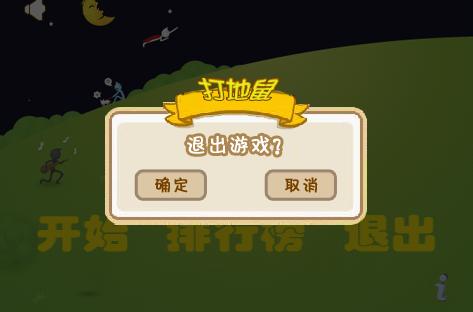本文实例讲述了android编程自定义alertdialog(退出提示框)用法,分享给大家供大家参考,具体如下:
有时候我们需要在游戏或应用中用一些符合我们样式的提示框(alertdialog)
以下是我在开发一个小游戏中总结出来的.希望对大家有用.
先上效果图:

下面是用到的背景图或按钮的图片
经过查找资料和参考了一下例子后才知道,要实现这种效果很简单.就是在设置alertdialog的contentview.
以下的代码是写在activity下的,代码如下:
|
1
2
3
4
5
6
7
8
9
10
11
12
13
14
15
16
17
18
19
20
21
22
23
24
25
26
27
28
29
|
public boolean onkeydown(int keycode, keyevent event) { // 如果是返回键,直接返回到桌面 if(keycode == keyevent.keycode_back || keycode == keyevent.keycode_home){ showexitgamealert(); } return super.onkeydown(keycode, event);}private void showexitgamealert() { final alertdialog dlg = new alertdialog.builder(this).create(); dlg.show(); window window = dlg.getwindow(); // *** 主要就是在这里实现这种效果的. // 设置窗口的内容页面,shrew_exit_dialog.xml文件中定义view内容 window.setcontentview(r.layout.shrew_exit_dialog); // 为确认按钮添加事件,执行退出应用操作 imagebutton ok = (imagebutton) window.findviewbyid(r.id.btn_ok); ok.setonclicklistener(new view.onclicklistener() { public void onclick(view v) { exitapp(); // 退出应用... } }); // 关闭alert对话框架 imagebutton cancel = (imagebutton) window.findviewbyid(r.id.btn_cancel); cancel.setonclicklistener(new view.onclicklistener() { public void onclick(view v) { dlg.cancel(); } });} |
以下的是layout文件,定义了对话框中的背景与按钮.点击事件在activity中添加.
文件名为 : shrew_exit_dialog.xml
|
1
2
3
4
5
6
7
8
9
10
11
12
13
14
15
16
17
18
19
20
21
22
23
24
25
26
27
28
29
30
|
<?xml version="1.0" encoding="utf-8"?><relativelayout xmlns:android="http://schemas.android.com/apk/res/android" android:layout_height="wrap_content" android:layout_width="wrap_content"> <!-- 退出游戏的背景图 --> <imageview android:id="@+id/exitgamebackground" android:layout_centerinparent="true" android:layout_height="wrap_content" android:layout_width="wrap_content" android:src="@drawable/bg_exit_game" /> <!-- 确认按钮 --> <imagebutton android:layout_alignbottom="@+id/exitgamebackground" android:layout_alignleft="@+id/exitgamebackground" android:layout_marginbottom="30dp" android:layout_marginleft="35dp" android:id="@+id/btn_ok" android:layout_height="wrap_content" android:layout_width="wrap_content" android:background="@drawable/btn_ok" /> <!-- 取消按钮 --> <imagebutton android:layout_alignbottom="@+id/exitgamebackground" android:layout_alignright="@+id/exitgamebackground" android:layout_marginbottom="30dp" android:layout_marginright="35dp" android:id="@+id/btn_cancel" android:layout_height="wrap_content" android:layout_width="wrap_content" android:background="@drawable/btn_cancel" /></relativelayout> |
就这样经过了以上几步,就可以实现自定义alertdialog的效果了. 用同样的思路可以实现其它更复杂的效果.
希望本文所述对大家android程序设计有所帮助。














